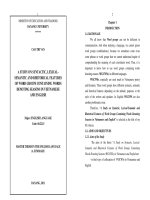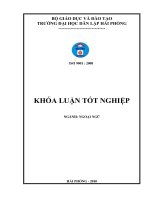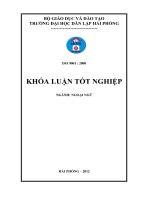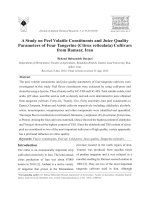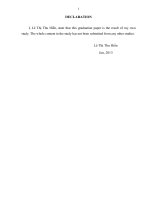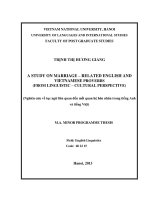A study on bottom spray granulation and its potential applications
Bạn đang xem bản rút gọn của tài liệu. Xem và tải ngay bản đầy đủ của tài liệu tại đây (3.34 MB, 234 trang )
A STUDY ON BOTTOM-SPRAY GRANULATION AND
ITS POTENTIAL APPLICATIONS
ER ZHI LIN DAWN
NATIONAL UNIVERSITY OF SINGAPORE
2010
A STUDY ON BOTTOM-SPRAY GRANULATION AND
ITS POTENTIAL APPLICATIONS
ER ZHI LIN DAWN
B.Sc. (Pharm.) Hons., NUS
A THESIS SUBMITTED
FOR THE DEGREE OF DOCTOR OF PHILOSOPHY
DEPARTMENT OF PHARMACY
NATIONAL UNIVERSITY OF SINGAPORE
2010
ii
ACKNOWLEDGEMENTS
I would like to express my heartfelt thanks to my supervisors, Asst. Prof Celine Liew and A/P
Paul Heng for their guidance and the opportunities they have given me to learn and grow
during the course of my study.
I am indebted to NUS for providing me with a research scholarship to fund this higher degree,
and to the Department of Pharmacy and its administrators for the facility and support during
my candidature.
I also wish to thank A/P Chan Lai Wah for her concern and advice throughout my candidature.
Special thanks to Mrs Teresa Ang, Mr Peter Leong and Ms Wong Mei Yin, the laboratory
technologists during my course of study for their technical assistance.
I am fortunate to have been in the company of a group of supportive and helpful fellow
postgraduates in GEA-NUS PPRL. They have made the laboratory a very pleasant and
conducive place to work in. I would like to especially thank Elaine, Zhihui, Sook Mun, Yihui,
Atul, Likun, Stephanie, Wun Chyi and Christine for their invaluable friendship.
Finally, my deepest gratitude belongs to my dear family and friends, especially to my parents,
for their faith and belief in me. I am grateful to my beloved husband, Dale, for his loving
support and patience during this work. I will also like to thank my best friend, Serena, for her
constant encouragement.
Dawn, 2010
iii
DEDICATION
For my parents, Chin Lam and Hwee Kiang
Table of contents
iv
TABLE OF CONTENTS
ACKNOWLEDGEMENTS ii
DEDICATION iii
TABLE OF CONTENTS iv
SUMMARY x
LIST OF TABLES xii
LIST OF FIGURES xiv
LIST OF SYMBOLS xvii
I. INTRODUCTION 2
A. BACKGROUND 2
A1. Significance of granulation 2
A2. Types of granulation 4
A2.1. Dry granulation processes 4
A2.2. Wet granulation processes 5
B. FLUIDIZED BED GRANULATION 9
B1. Techniques of spray 11
B2. Advantages and challenges 14
B3. Parameters influencing the process and granule quality 16
B3.1. Material related factors 17
B3.2. Process related factors during the liquid binder addition
phase 20
B3.3. Process related factors during the drying phase 22
C. RECENT ADVANCES IN FLUIDIZED BED GRANULATION 25
C1. Process analytical technology (PAT) in fluidized bed granulation 25
C1.1. Moisture content 26
Table of contents
v
C1.2. Particle size 27
C1.3. Composition of bed material 28
C1.4. Solid state transformations 28
C2. Fluidized bed granulation methods 29
C2.1. Fluidized bed melt granulation 29
C2.2. Fluidized bed binderless granulation 31
C2.3. Bottom-spray granulation 32
II. HYPOTHESIS AND OBJECTIVES 40
A. HYPOTHESIS 40
B. OBJECTIVES 41
III. EXPERIMENTAL 44
A. MATERIALS 44
A1. Feed material 44
A2. Liquid binder 44
A3. Model drugs 44
A4. Tablet excipients 45
A5. Chemicals for dissolution media preparation and high
performance liquid chromatography (HPLC) analyses 46
B. METHODS 47
B1. Feed material 47
B1.1. Blending of powder 48
B1.2. Determination of powder particle size 48
B1.3. Determination of powder flow with angle of repose 48
B2. Liquid binder 49
B2.1. Micronization of HCT 49
Table of contents
vi
B2.2. Determination of particle size of micronized HCT 50
B2.3. Preparation of HCT-incorporated liquid binder 50
B3. Granulation process 50
B3.1. Real-time measurement of process conditions 52
B3.2. Determination of process drying efficiency 54
B3.3. Determination of granule bed temperature profiles 54
B3.4. Determination of capacity for moisture removal 55
B3.5. Determination of granule bed moisture content profiles 55
B3.6. Determination of air velocity within partition column 56
B3.7. Determination of process yield 56
B4. Characterization of granules 57
B4.1. Granule size 57
B4.2. Granule shape 57
B4.3. Granule surface morphology 58
B4.4. Granule flow 58
B4.5. Granule porosity 59
B4.6. Granule friability 59
B4.7. Content determination of HCT in granules 60
B4.8. Dissolution of HCT from granules 61
B4.9. Amount of ASA degradation 61
B5. Compaction process 63
B5.1. Heckel plot analysis 64
B6. Characterization of tablets 65
B6.1. Tablet surface morphology and roughness 65
B6.2. Tablet porosity 66
Table of contents
vii
B6.3. Tablet tensile strength 67
B6.4. Disintegration of tablets 67
B6.5. Dissolution of HCT from tablets 67
B7. Statistical analyses 68
B7.1. Design-of-Experiment and response surface modelling 68
B7.2. Multivariate data analysis 69
B7.3. Regression analyses 69
B7.4. Other data analyses 70
B7.5. Level of significance 70
IV. RESULTS AND DISCUSSION 72
A. ROLE OF FLUID DYNAMICS AND WETTING ON GRANULE
FORMATION IN PG 72
A1. Factors influencing air velocity within the partition column 73
A2. Factors influencing characteristics of granule batches 77
A2.1. Influence of variables on process yield 77
A2.2. Influence of variables on granule size and size distribution 85
A2.2.1. Influence of variables on fines 85
A2.2.2. Influence of variables on lumps 88
A2.2.3. Influence of variables on modal size fraction 89
A2.2.4. Influence of variables on MMD 89
A2.2.5. Influence of variables on span 91
A2.3. Influence of variables on granule shape 91
A2.4. Influence of variables on granule flow 95
B. APPLICABILITY OF PG AND TG FOR SPRAY DEPOSITION OF
DRUG DURING GRANULATION 96
Table of contents
viii
B1. Drug content and drug content uniformity of PG and TG granules 96
B2. Impact of particle circulation pattern and fluid dynamics in PG
and TG on granule growth 99
B2.1. Resultant mode of granule growth in PG and TG 102
B2.2. Process sensitivity to binder spray rate and the resultant
influences on granule growth 106
B2.3. Process sensitivity to particle size of feed material and the
resultant influences on granule growth 112
B3. Drug release properties of PG and TG granules 117
B4. Flow properties of PG and TG granules 119
C. COMPACTIBILITY STUDY ON PG AND TG GRANULES 120
C1. Compaction behaviour of PG and TG granules 120
C1.1. Influence of compactibility of granules on tablet properties 126
C1.2. General relation between granule characteristics, granule
compactibility and tablet properties 136
C2. Compaction behaviour of PG and TG granules with tablet
excipients 142
C2.1. Influence of compactibility of granules on disintegrant
efficacy 145
D. INVESTIGATIVE STUDY ON THE ABILITY OF PG TO
GRANULATE MOISTURE SENSITIVE DRUGS 150
D1. ASA stability in PG and TG during processing 150
D1.1. Impact of particle circulation pattern and fluid dynamics in
PG and TG on ASA stability 155
D1.2. Influence of inlet air temperature and binder spray rate 158
Table of contents
ix
D2. Factors influencing processing conditions and ASA stability in
PG 161
D2.1. Influence of AAI diameter 163
D2.2. Influence of inlet air temperature 164
D2.3. Influence of binder spray rate 165
V. CONCLUSION 168
VI. REFERENCES 172
VII. LIST OF PUBLICATIONS 211
Summary
x
SUMMARY
The potential of bottom-spray fluidized bed granulation has not been fully realized as
research in this area had been rather limited. However with current advances in
fluidized bed equipment, there is growing interest in using the bottom-spray technique
for granulation. The gap in scientific knowledge and the improved, modified Wurster
system introduced recently, precision granulation, provided the much needed impetus
for this study.
A 3
3
full factorial design was employed to investigate the role of fluid dynamics and
wetting on granule formation in this process. The three factors investigated include air
accelerator insert, partition gap and binder spray rate. Measured air velocity within the
partition column was found to be largely influenced by the diameter of the air
accelerator insert and dictated granule growth in which a positive correlation to
granule size was exhibited. The partition gap played an important role in transporting
particles into the spray granulation zone, whereas the binder spray rate affected
granule shape. Unlike conventional top-spray granulation, fluid dynamics in the
bottom-spray process can be easily modulated by using different air accelerator
inserts and partition gaps to allow for flexible control of granule size, shape and flow.
The highly ordered particle circulation pattern and unique fluid dynamics in the
bottom-spray bed resulted in the presence of distinct cyclical phases of wetting,
growth and drying during granulation, thereby favouring layered growth. The strong
impact of fluid dynamics on granule growth in the bottom-spray process was observed
to cause relative insensitivity to wetting and a stronger dependence on feed material
characteristics in comparison to the top-spray process. Unlike agglomerate formation
Summary
xi
by solidification of liquid bridges with the top-spray technique, layered growth with
the bottom-spray technique was found to cause precise spray deposition of drug
particles onto feed particles during granulation. The bottom-spray granules were
observed to be stronger, more spherical and flowed better than top-spray granules. A
smaller extent of granule rearrangement and slippage occurred during compaction,
and these bottom-spray granules were also found to yield more readily through plastic
deformation under pressure. The resultant tablet properties were found to be generally
similar between the two types of granules.
The highly ordered particle circulation pattern and unique fluid dynamics in bottom-
spray processing were also shown to be more advantageous to the chemical stability
of a moisture sensitive drug in comparison to the top-spray process. This was
attributed to confined, localized granulation within the partition column, with rapid
drying “targeted” at the granules after wetting. A reduction in processing time without
any adverse effect on drug stability was possible with employment of high inlet air
temperature and high binder spray rate using the bottom-spray process, provided that
process drying efficiency was not compromised.
Precision granulation was found to be an attractive alternative to the conventional top-
spray granulation process. The findings in this study were encouraging for they
highlighted the suitability of particle circulation pattern and fluid dynamics in this
process for (i) spray deposition of a micronized drug during granulation and (ii) wet
granulation of a moisture sensitive drug.
List of tables
xii
LIST OF TABLES
Table 1. Compositions of powder blends used as feed material. 47
Table 2. Formulations of liquid binder used for granulation. 49
Table 3. Process variables and their operating conditions in PG and TG. 53
Table 4. Factorial design: variables and their defined levels. 68
Table 5. Response surface modelling: regression coefficients of effect of
variables on characteristics of the granule batches. 79
Table 6. Effect of variables on characteristics of granule batches. 80
Table 7. Analysis of variance of effect of variables on characteristics of the
granule batches. 82
Table 8. Influence of binder spray rate on PG and TG granule properties. 108
Table 9. MMD, span and angle of repose of the various lactose blends. 113
Table 10. Influence of lactose powder blend on PG and TG granule properties.
116
Table 11. Influence of binder spray rate on drug release (in deionized water)
from PG and TG granules. 118
Table 12. Characteristics of PG and TG granules in size fraction 355 to 500
µm. 120
Table 13. Heckel plot parameters and properties of tablets formed from PG
and TG granules. 123
Table 14. Pearson’s coefficients of correlated variables. 140
Table 15. Size and dissolution properties of PG and TG granules used to
prepare tablets for disintegration and dissolution studies. 143
Table 16. Heckel plot parameters of PG and TG tablets with different
disintegrants incorporated. 144
Table 17. Disintegration and drug release properties of PG and TG tablets
with different disintegrants incorporated. 146
Table 18. Processing conditions and granule properties in PG and TG. 152
Table 19. Influence of variables on processing conditions, granule properties
and amount of ASA degradation in PG. 162
List of tables
xiii
Table 20. Influence of AAI diameter on air velocity and transit time. 163
List of figures
xiv
LIST OF FIGURES
Figure 1. Nucleation, growth and breakage phenomena in wet granulation
processes, adapted from Ennis and Litster (1997). 7
Figure 2. Diagram of a MP-1 air handling system showing the parts and
locations at which the following process parameters were measured:
(a) ambient temperature, (b) inlet air relative humidity, (c) airflow
rate, (d) inlet air temperature, (e) granule bed temperature, (f)
outlet air relative humidity and (g) outlet air temperature. Arrows
indicate the direction of air flow. 10
Figure 3. Schematic diagrams of (a) top-spray granulator, (b) tangential-spray
granulator: double chamber rotary processor and (c) bottom-spray
granulator. Arrows represent air flow. 12
Figure 4. Photographs of PG features: (a) air distribution plate showing
central orifice, (b) air distribution plate showing graduated open
area, (c) AAIs of various opening diameters and (d) air swirl
accelerator. 34
Figure 5. Assembled PG module. 37
Figure 6. Hydrolytic reaction of ASA 45
Figure 7. Photographs of (a) PG and (b) TG modules fitted onto the MP-1 air
handling system. 51
Figure 8. Schematic diagram showing the air distribution and zones in the PG
process, with arrows representing airflow. 74
Figure 9. Influence of (a) partition gap (AAI diameter of 30 mm) and (b) AAI
diameter (partition gap of 26 mm) on air velocity within the
partition column at airflow rates of 50 ( ), 60 ( ), 70 ( ), 80 ( ), 90
( ), 100 ( ) and 110 ( ) m3/h. Error bars represent standard
deviation among independent runs. 76
Figure 10. Air velocity within the partition column (averaged across airflow
rates of 50, 60, 70, 80, 90, 100 and 110 m
3
/h) at defined conditions
of the factorial design. 78
Figure 11. Response surface graphs of the effect of (a) AAI diameter and
binder spray rate (hold values at partition gap = 26 mm) on fines
and (b) AAI diameter and partition gap (hold values at binder
spray rate = 21 g/min) on lumps. 87
List of figures
xv
Figure 12. Response surface graphs of the effect of (a) AAI diameter and
partition gap (hold values at binder spray rate = 21 g/min) and (b)
binder spray rate and partition gap (hold values at AAI diameter
= 29.5 mm) on aspect ratio. 93
Figure 13. Mean drug content of PG and TG granules: PG/small ( ),
PG/medium ( ), PG/large ( ), TG/small ( ), TG/medium ( )
and TG/large ( ) when (a) binder spray rate and (b) lactose
powder blend were varied. Error bars represent inter-batch
standard deviation. 97
Figure 14. Mean RSD of drug content of PG and TG granules: PG/small ( ),
PG/medium ( ), PG/large ( ), TG/small ( ), TG/medium ( ) and
TG/large ( ) when (a) binder spray rate and (b) lactose powder
blend were varied. Error bars represent inter-batch standard
deviation. Values in parentheses denote mean amounts of small,
medium and large granules within the batches (%, w/w). 100
Figure 15. Overall weighted RSD of drug content of PG (■) and TG (□)
batches when (a) binder spray rate and (b) lactose powder blend
were varied. 101
Figure 16. Mode of wetting and granule growth in PG and TG. 103
Figure 17. Schematic diagram showing the air flow pattern and zones in the
TG process with arrows representing airflow. 105
Figure 18. Scanning electron photomicrographs of PG and TG granules
(taken at 100 x magnification) prepared with various binder spray
rates. 109
Figure 19. Scanning electron photomicrographs showing overview of (a) PG
and (b) TG granules (taken at 35 × magnification) prepared with
binder spray rate of 21 g/min. 111
Figure 20. Influence of feed material on MMD (■,□) and span (●,○) in PG
(closed symbols) and TG (open symbols). Error bars represent
inter-batch standard deviation. 115
Figure 21. Heckel plots of PG (■) and TG (□) granules with ( ) and
( ) representing the regressed lines (PG: y = 0.0071x + 1.0, R
2
= 0.995; TG: y = 0.0065x + 1.1, R
2
= 0.992) respectively. Error
bars represent inter-batch standard deviation. 121
Figure 22. PG and TG granules in powder bed with increasing compaction
pressures. 125
Figure 23. Optical photomicrographs of macro-surfaces (taken at 1.2 ×
magnification) of PG and TG tablets. 127
List of figures
xvi
Figure 24. Micro-surface roughness, (a) R
a
and (b) R
q
of PG (■) and TG (□)
tablets with ( ) and ( ) representing the regressed lines
(PG/R
a
: y = 10651e
-0.140x
, R
2
= 0.947; TG/R
a
: y = 12614e
-0.151x
, R
2
= 0.940; PG/R
q
: y = 14610e
-0.135x
, R
2
= 0.947; TG/R
q
: y = 16983e
-
0.143x
, R
2
= 0.940) respectively: Error bars represent inter-batch
standard deviation. 130
Figure 25. Three-dimensional plots of micro-surfaces (taken at 20.64 ×
magnification) of PG and TG tablets. 131
Figure 26. Porosity of PG (■) and TG (□) tablets with ( ) and ( )
representing the regressed lines (PG/porosity: y = 0.414e
-0.008x
, R
2
= 0.980; TG/porosity: y = 0.403e
-0.008x
, R
2
= 0.976) respectively.
Error bars represent inter-batch standard deviation. 134
Figure 27. Tensile strength of PG (
■) and TG (□) granules with ( ) and
( ) representing the regressed lines (PG/tensile strength: y =
0.022x – 0.29, R
2
= 0.997; TG/tensile strength: y = 0.019x – 0.24,
R
2
= 0.997) respectively. Error bars represent inter-batch standard
deviation. 135
Figure 28. Loadings plot of data related to granule characteristics ( ■ ),
compactibility (●) and tablet properties (▲). 137
Figure 29. Moisture content (■,□) and bed temperature (●,○) in PG (closed
symbols) and TG (open symbols): (a) PG at condition LL (b) TG
at condition LL, (c) PG at condition HH and (d) TG at condition
HH. Error bars denote inter-batch standard deviation. 153
List of symbols
xvii
LIST OF SYMBOLS
A
constant of Heckel plot
AAI air accelerator insert
ASA acetylsalicylic acid
AUC
hea
t
area under the temperature against time curve
AUC
moisture
area under the moisture content against time curve
a
cross-sectional area
b
breadth
D
relative density
D
0
initial relative density
D
a
pp
apparent density
D
a
extrapolated relative density from the intercept of the linear
portion of the Heckel plot
D
b
increase in relative density due to particle rearrangement
D
p
particle true density
D
t
true density
Drug
x
drug content of a specific size fraction x
d
tablet diameter
d
10
particle diameter at the 10 percentile of the cumulative percent
undersize plot
d
50
particle diameter at the 50 percentile of the cumulative percent
undersize plot
d
90
particle diameter at the 90 percentile of the cumulative percent
undersize plot
d
99
particle diameter at the 99 percentile of the cumulative percent
undersize plot
F
tablet hardness
List of symbols
xviii
HCT hydrochlorothiazide
HH condition of high inlet air temperature and high binder spray
rate
HPLC high performance liquid chromatography
h
tablet height
h
b
absolute humidity of the air at the granule bed at 100 %
relative humidity
h
i
absolute humidity of inlet air
h
o
absolute humidity of outlet air
k
slope of Heckel plot
LL condition of low inlet air temperature and low binder spray
rate
l
length
MMD mass median diameter
m
a
airflow rate
m
l
liquid flow rate
N
A
SA
number of moles of acetylsalicylic acid
N
SA
number of moles of salicylic acid
NIR near infrared
P
applied pressure
PAT process analytical technology
PC1 and PC2 first and second principal components
PG precision granulation
p
r
perimeter
p
x
proportion of a specific size fraction x
R
a
arithmetic average roughness
R
q
root mean square of roughness
List of symbols
xix
RSD relative standard deviation
RSD
x
relative standard deviation of drug content of a specific size
fraction x
r
correlation coefficient
TG top-spray granulation
t
dis
disintegration time
t
50%
time at 50 percentile of dissolution plot
t
90%
time at 90 percentile of dissolution plot
USP United States Pharmacopeia
v
volume before tapping
v
c
constant volume obtained after tapping
W
weight
W
g
actual batch weight of collected granules after processing
W
t
theoretical batch weight of granules after processing
w
i
initial weight of granules
w
f
final weight of granules
X
1
, X
2
and X
3
first, second and third linear terms in regression equation
X
A
linear term (air accelerator insert) in response surface equation
X
P
linear term (partition gap) in response surface equation
X
S
linear term (binder spray rate) in response surface equation
X
AA
squared term (air accelerator insert × air accelerator insert) in
response surface equation
X
PP
squared term (partition gap × partition gap) in response
surface equation
X
SS
squared term (binder spray rate × binder spray rate) in
response surface equation
X
AP
interaction term (air accelerator insert × partition gap) in
response surface equation
List of symbols
xx
X
AS
interaction term (air accelerator insert × binder spray rate) in
response surface equation
X
PS
interaction term (partition gap × binder spray rate) in response
surface equation
X
a
f
linear term (airflow rate) in regression equation
X
A
A
I
linear term (air accelerator insert) in regression equation
X
hea
t
linear term (inlet air temperature) in regression equation
X
moisture
linear term (binder spray rate) in regression equation
Y
response
Y
as
p
response (aspect ratio) in response surface equation
Y
ASA
response (amount of acetylsalicylic degradation) in regression
equation
Y
f
ines
response (fines) in response surface equation
Y
lum
p
s
response (lumps) in response surface equation
Y
vel
response (air velocity within the partition column) in
regression equation
β
0
constant
β
1
, β
2
and β
3
coefficient of first, second and third linear terms in regression
equation
β
A
coefficient of linear term (air accelerator insert) in response
surface equation
β
P
coefficient of linear term (partition gap) in response surface
equation
β
S
coefficient of linear term (binder spray rate) in response
surface equation
β
AA
coefficient of squared term (air accelerator insert × air
accelerator insert) in response surface equation
β
PP
coefficient of squared term (partition gap × partition gap) in
response surface equation
β
SS
coefficient of squared term (binder spray rate × binder spray
rate) in response surface equation
List of symbols
xxi
β
AP
coefficient of interaction term (air accelerator insert ×
partition gap) in response surface equation
β
AS
coefficient of interaction term (air accelerator insert × binder
spray rate) in response surface equation
β
PS
coefficient of interaction term (partition gap × binder spray
rate) in response surface equation
1
PART I:
INTRODUCTION
Introduction
2
I. INTRODUCTION
A. BACKGROUND
The production of dosage forms in the pharmaceutical industry is a complex multi-
stage process involving numerous unit operations. Granulation, one of the key
operations, is a size-enlargement process whereby small particles are gathered into
larger masses while maintaining good control of the size and microstructure of the
product. A binder, either in liquid or solid form, is usually incorporated to promote
agglomeration of particles, and the product formed is termed as granules. The
granulation process generally produces granules of a wide size distribution within the
range of 0.1 to 3 mm (Appelgren, 1985). In most cases, granulated powders are for
production of tablets or caplets and these batches of granules with wide size
distributions served as intermediate products. The active ingredient can be granulated
by itself and then the resultant drug granules blended with other excipients prior to
tablet compaction or capsule filling. Alternatively, the active ingredient is co-
granulated with most or all of the excipients. Granules prepared may also be
subsequently coated and filled into capsules (Schwartz, 1988).
A1. Significance of granulation
Granules show more desirable properties than fine powders as granulated powders
resist segregation and are easier to handle. Uniform, non-segregating blends of fine
materials produced after granulation ensure a definite quantity fill of all the
constituents in the correct proportion in the dies. The problem of dust generation is
addressed, reducing handling hazards of toxic materials and material losses. The bulk
volume of voluminous powder is reduced, making it more convenient for storage and
Introduction
3
transport. The flow, compaction characteristics and appearance of granulated powders
are also better compared to fine powders (Stanley-Wood, 1990). The improved flow
properties help to ensure that the granules flow well through chutes and hoppers into
small volume dies without great variation in weight during tabletting. Granules are
more easily compacted compared to fine powders and produce stronger tablets due to
the presence of well-distributed binders within the granule structures. Another
advantage includes reduced caking and lump formation for hygroscopic materials
after granulation (Kristensen and Schaefer, 1993; Summers and Aulton, 2001).
Due to the simpler and lower cost manufacturing operations associated with preparing
granules for tabletting or capsule filling, there is interest in using similar unit
operations for the preparation of modified release granules. Many other researchers
have shown that controlled release of drug from the tablet matrices can be prepared by
granulating the drug with various polymeric excipients to form slow release granules
(Radtke et al., 2002; Sakkinen et al., 2002; Vaithiyalingam et al., 2002;
Mukhodpadhyay et al., 2005). Promising results have similarly been shown in studies
on rapid release granules, with reports on enhancement in drug dissolution after
granulation (Ghorab and Adeyeye, 2001; Gupta et al., 2001, 2002). In addition to the
development of suitable formulations, the development of novel granulation
techniques, such as steam granulation (Rodriguez, 2002), melt granulation (Perissutti
et al., 2003; Seo et al., 2003; Vilhelmsen et al., 2005; Yang et al., 2007) and
ultrasonic spray congealing (Passerini et al., 2006) for the preparation of rapid release
granules have understandably gained more attention.

